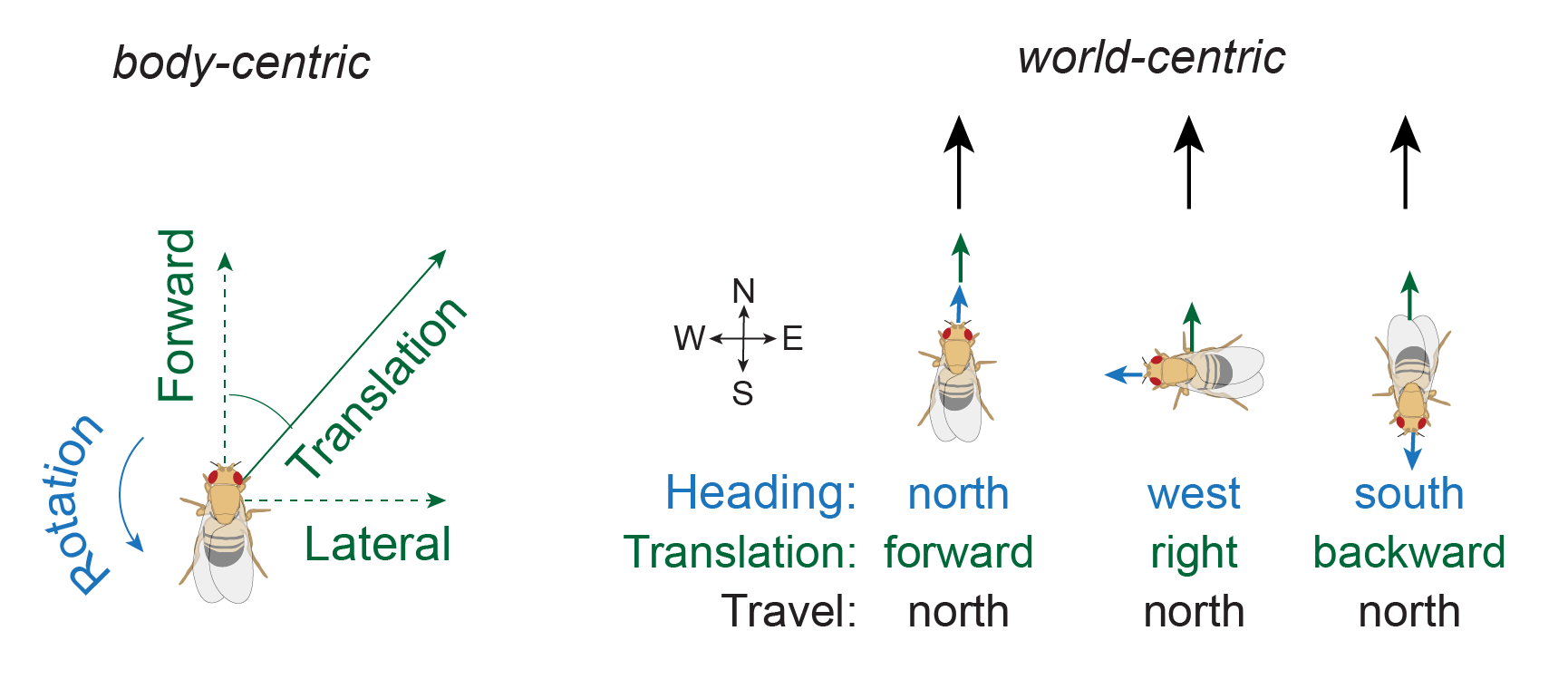By Jenny Lu
We can describe our movement relative to ourselves – walking forward and slightly to the right, for example – or relative to the world around us – walking from Fenway southwest towards Longwood campus. Both frames of reference are useful during navigation: external cues in world-centric coordinates guide decision-making and goal selection, and our own motor commands are ultimately sent in body-centric coordinates. We know of many behaviors and tasks across animal species that require such body-centric to world-centric transformations, but how neural circuits precisely accomplish these computations has remained unknown.
Our study identified a neural circuit in a region of the Drosophila brain called the fan-shaped body that converts the fly’s walking velocity from a body-centric to a world-centric reference frame. To examine neural activity during navigation, we tethered flies in a virtual reality arena on a spherical treadmill while performing two-photon calcium imaging or electrophysiology. We looked downstream of a previously-identified heading direction circuit to identify two cell types that encode both the heading direction and the body-centric walking velocity of the fly. Collectively, these two cell types, called PFNd and PFNv, cover the entire space of heading direction and body-centric velocity combinations. One such combination, for example, might be a fly facing north (its heading direction) but walking backwards (its body-centric velocity).
We wondered what neurons downstream of PFNd and PFNv cells would encode. Using the available electron microscopy reconstructions and annotations of the fly brain, we observed that one of the major downstream targets was a third cell type called hΔB. We also noticed an interesting connectivity motif based on our functional data: hΔB neurons appeared to pool together heading and translation direction combinations corresponding to the same movement in world-centric space. For example, one such hΔB neuron would thus encode fly velocity in the world-centric southward direction and would be active whether the fly was facing south while walking forward or facing north while walking backward.

Schematic showing movement directions in body-centric versus world-centric space. On the left, in body-centric coordinates the walking fly can have rotational and translational velocity. On the right, each of the three example flies has a different heading direction and body-centric translational velocity direction, but all three have the same world-centric travel velocity direction.
We constructed a computational model using the connectivity data from the electron microscopy connectome and our physiology data from calcium imaging and electrophysiology. We then examined the calcium activity of hΔB neurons as the fly walked in virtual reality. Both model and experiment confirmed our intuition that hΔB neurons encode world-centric fly velocity.
This circuit is likely involved in a variety of insect navigation behaviors. Flies can perform idiothetic path integration, in which they keep track of their own movements to remember their location relative to a starting position. Indeed, perturbing PFNd neurons disrupted flies’ accuracy in performing a path integration task.
Our work reveals how precise connectivity between topographic neural maps allows the fly to perform complex vector computations such as coordinate transformations. The circuit described in our study is just one of many processing layers within the navigational neuropils of the fly. Combining connectomics, physiology, modeling, and behavioral techniques will allow us to further dissect the neural computations the fly makes as it navigates the world.
Jenny Lu is an MD-PhD candidate at Harvard Medical School and completed her PhD in the lab of Rachel Wilson.
Learn more in the original research article:
Transforming representations of movement from body- to world-centric space.
Lu J, Behbahani AH, Hamburg L, Westeinde EA, Dawson PM, Lyu C, Maimon G, Dickinson MH, Druckmann S, Wilson RI. Nature. 2022;601(7891):98-104
News Types: Community Stories
